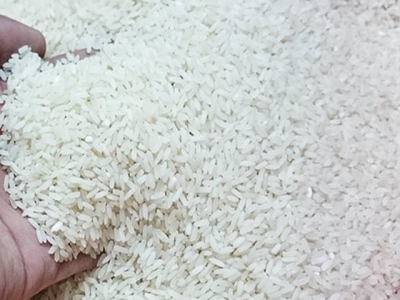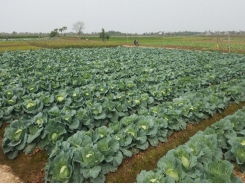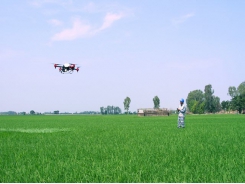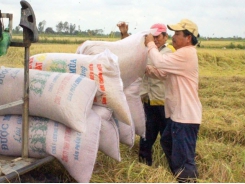Vietnam continues rice industry restructuring

Vietnam will continue to restructure the rice industry in the direction of improving efficiency and sustainable development towards the objectives of fully meeting domestic consumption demand, being the core in ensuring national food security, and enhancing the efficiency of the rice value chain.
Vietnam will continue to restructure the rice industry in the time ahead. Photo: VNA
The Ministry of Agriculture and Rural Development has just approved a project on restructuring the Vietnam's rice industry until 2025 with a vision to 2030.
Accordingly, Vietnam will continue to restructure the rice industry in the direction of improving efficiency and sustainable development towards the objectives of fully meeting domestic consumption demand, being the core in ensuring national food security, and enhancing the efficiency of the rice value chain.
Under the project, Vietnam also expects to adapt to climate change and mitigate the impacts of climate change, make efficient use of natural resources and protect the ecological environment, and increase income for farmers and benefits for consumers, in addition to exporting high quality and high value rice.
The country also plans to keep its rice area at 3.6 to 3.7 million hectares by 2025, with rice production of 40 to 41 million tonnes per year, Nhan dan (People) newspaper reported.
The rice industry also aims at exporting 5 million tonnes of rice each year by 2025, including 40 percent fragrant rice, specialty rice and japonica rice, 20 percent sticky rice, 20 percent high quality rice, 15 percent medium and low-grade rice, and 5 percent products processed from rice. The percentage of branded rice exports is over 20 percent.
The country sets the target of exporting 4 million tonnes of rice by 2030, including 45 percent fragrant rice, specialty rice and japonica rice, 20 percent sticky rice, 15 percent high quality rice, 10 percent medium and low-grade rice, and 10 percent products processed from rice, with over 40 percent branded rice exports.
A notable aspect of the project is that the rice export volume has decreased gradually in each period, but the criteria for specialty rice, high quality rice, processed products from rice, and percentage of branded rice exports sees increases year by year.
This shows that the future direction of the rice industry is to reduce the area and output for export towards a focus on improving rice quality and selling prices.
This is the right target which is suitable to the current situation of rice production and export, particularly in the context that Vietnam has signed many free trade agreements (FTAs) with international partners, such as the EU-Vietnam Free Trade Agreement (EVFTA), the Regional Comprehensive Economic Partnership (RCEP), and the UK-Vietnam Free Trade Agreement (UKVFTA).
Vietnam earned over 3 billion USD from exporting rice in 2020, according to the Vietnam Food Association (VFA), a year-on-year increase of more than 10 percent.
The rice sector is expected to again post high growth this year, when new-generation free trade agreements (FTAs) Vietnam has signed with foreign partners come into play.
Amid the difficulties posed by the ongoing COVID-19 pandemic, rice exporters quickly made appropriate adjustments and actively sought new markets while fully tapping into the advantages brought about by FTAs, according to the VNA.
Vice Chairman of the VFA, Do Ha Nam, said 2020 was a successful year for Vietnam’s rice exports, which he attributed to increasing demand in many countries and the improved competitiveness of Vietnamese rice around the world.
The EU-Vietnam FTA (EVFTA) has created a major opportunity for Vietnamese rice to enter European markets and then make inroads into other choosy markets, Nam said.
Experts said that if Vietnam wants to maintain rice export growth in 2021 it needs to focus on building a complete rice value chain and controlling quality in production, processing, and distribution.
The VFA predicted that rice exports will continue to grow this year because export markets, such as the Philippines and Africa, are continuing to sign contracts.
Within the framework of the Vietnam-Eurasian Economic Union (EAEU) FTA, EAEU member states have pledged to give Vietnam a tariff quota of 10,000 tonnes of rice for this year.
Vietnam’s rice exports to the UK will also enjoy zero percent tariffs without quotas under the recently-signed UK-Vietnam FTA.
To fully tap into the advantages available under FTAs, rice export giants such as the Intimex Corporation JSC, the Loc Troi Group, the VRICE Co., and the Trung An Hi-Tech Agriculture JSC are planning to seek additional importers in markets where Vietnam has signed FTAs, especially in the UK.
The Ministry of Industry and Trade will continue to support exporters via providing timely information on market demand and strengthening trade promotion efforts.
Có thể bạn quan tâm
Phần mềm

Phối trộn thức ăn chăn nuôi

Pha dung dịch thủy canh

Định mức cho tôm ăn

Phối trộn phân bón NPK

Xác định tỷ lệ tôm sống

Chuyển đổi đơn vị phân bón

Xác định công suất sục khí

Chuyển đổi đơn vị tôm

Tính diện tích nhà kính

Tính thể tích ao hồ



 Business-cooperative-farmer linkage: Key to modern agriculture
Business-cooperative-farmer linkage: Key to modern agriculture  Vietnam urged to increase added value for rice…
Vietnam urged to increase added value for rice…